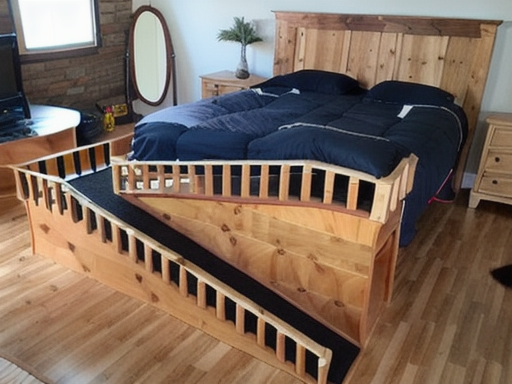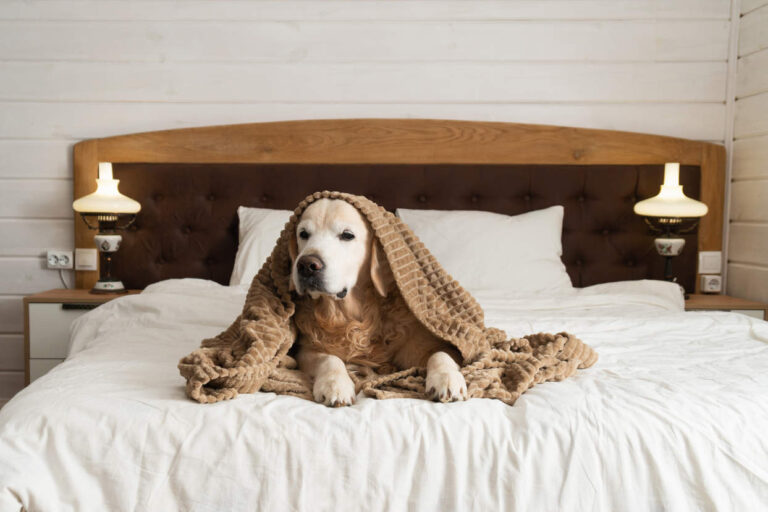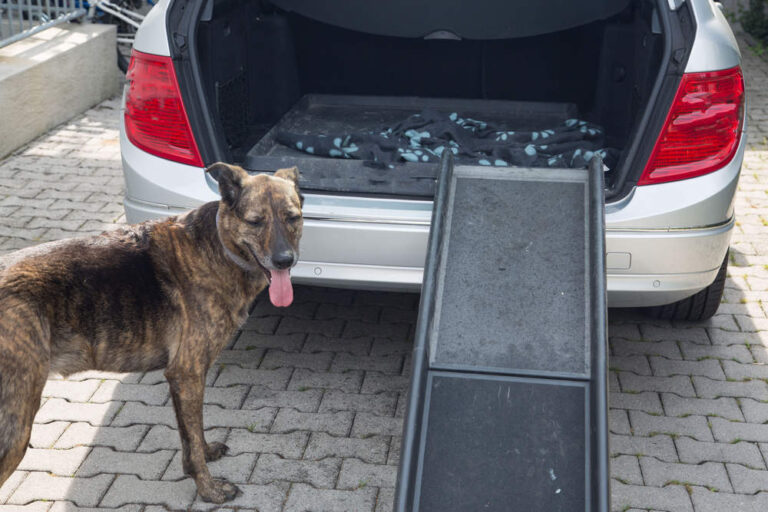A Guide To Pet Ramps – 10 Awesome Steps To Help You With Your Decision Making – Sit Back and Read On!
For the ultimate “A Guide To Pet Ramps,” find expert advice and essential tips. Ensure your furry friend’s safety and convenience.

A Complete Guide to Pet Ramps
Introduction
Pet ramps are an essential item for any pet owner looking to provide their furry friends safe access to beds, sofas, cars, and more. As pets get older or suffer from mobility issues like arthritis, climbing up into elevated spaces can become difficult or painful. Pet ramps act as a bridge to allow pets to move comfortably without added stress on their bodies.
In this comprehensive guide, we will cover everything you need to know about pet ramps including:
- Benefits of pet ramps
- Types of pet ramps
- Indoor vs. outdoor
- Steps vs. ramps
- Materials
- Important features to look for
- Safety considerations
- DIY vs. premade ramps
- Training your pet to use a ramp
- Proper set up and placement
- Care and maintenance
- Top recommended ramps
Armed with this information, pet owners can make the best decision when choosing a ramp to improve their pet’s quality of life.
Why Pet Ramps are Important
There are several key reasons why pet ramps have become such an important tool for responsible pet owners:
Prevents Injuries: Jumping up and down from furniture, cars, and other high places can lead to joint, muscle, and ligament injuries in pets, especially senior dogs. Providing a ramp reduces stress on the body during these movements.
Supports Mobility: Pets with mobility limitations due to age, obesity, or medical conditions can have difficulty getting to elevated surfaces. A ramp provides easy access to their favorite spots.
Pain Relief: Arthritic pets may find stairs painful but can still benefit from access to heights. Ramps provide a low-impact way for them to reach beds, sofas, cars, etc.
Independence: Ramps allow pets to navigate their environment without relying on their owner for help getting to preferred resting spots. This helps maintain dignity and self-sufficiency.
Safety: Unsteady or makeshift DIY ramps put pets at risk of falling or slipping. Quality commercial ramps give owners peace of mind about safety.
Bonding: Providing safe access to furniture, cars, and other spaces allows more shared experiences and bonding between pets and owners.
Types of Pet Ramps
Pet ramps come in several styles to suit different needs. Key factors in choosing a ramp are where it will be used (indoor vs. outdoor) and the needs of the pet.
Indoor Ramps
Indoor pet ramps are designed for providing access to furniture like beds, sofas, and chairs or for use in the home. There are a few types:
- Standard ramps: The most common type, these are single ramps placed at an incline to allow pets to walk up and down. They come in a range of sizes, materials, inclines, and weight limits to suit different needs.
- Stair ramps: These provide both stairs and a ramp for very low-mobility pets who need gradual incline. The stairs allow for rest periods.
- Tri-fold ramps: Folding ramps with three sections that fold out into a ramp then collapse for storage. They are ideal for travel or when space is limited.
Outdoor Ramps
Outdoor pet ramps are made to withstand the elements while providing access to vehicles or high porches/decks. Types include:
- Telescoping ramps: Made from aluminum or plastic, these ramps telescope out to adjustable lengths. Great for accessing vehicles.
- Heavy duty ramps: For larger pets, these ramps are reinforced for weights up to 300+ lbs and have grippy tread for outdoor use.
- Loading ramps: Designed for the rear of vehicles, these fold down to create a wider ramp area ideal for pets entering cargo vans and hatchbacks.
- Multipurpose ramps: Some ramps convert from indoor use to outdoor use with the addition of traction tread mats on the walking surface.
A Guide To Pet Ramps – Material Considerations
Pet ramps come in a variety of materials:
- Plastic: Lightweight but durable, plastic (polyethylene) ramps are waterproof and easy to clean. They’re affordable options good for small pets.
- Wood: Typically covered in carpet, wood offers an attractive look that blends into home décor. It’s heavier than other materials.
- Aluminum: Lightweight aluminum ramps are weather-resistant and good for outdoor use. They tend to be pricier but are very durable.
- Foam: Foam ramps are the lightest option, making them very portable. However, they lack grip and are less durable long-term.
Each material has pros and cons based on durability, weight, traction, and cost. Consider your needs when choosing.
Features to Look For in Pet Ramps
While shopping for the ideal pet ramp, keep in mind these important features:
- Rubber gripping on surface – Prevents slips and falls on the ramp.
- Reflective markers – Improves ramp visibility in low light.
- High weight capacity – Supports dogs up to 200lbs or more.
- Multiple size options – Accommodates everything from small dogs to large breeds.
- Portability – Foldable or telescoping ramps are great for travel.
- Detachable mats – Provides versatile indoor/outdoor use.
- Raised edges – Prevents pets from slipping off the sides of the ramp.
- Easy to clean materials – Allows quick cleaning of dirt, mud, and fur.
Prioritize features that will best match your pet’s size, home environment, and how you plan to use the ramp.
Using Pet Ramps Safely
While ramps greatly improve accessibility and safety, there are still some precautions owners should take:
- Choose a ramp rated for your pet’s full adult weight for adequate support.
- Supervise initial ramp use and assist pets if needed until they are comfortable.
- Ensure the ramp has a non-slip surface and is placed on a stable, non-slip floor surface.
- Position the ramp at the recommended angle – too steep is difficult to climb. Too shallow may lead to falls.
- Check the ramp for damage before each use. Discontinue use if any part is unstable or hazardous.
- Use tethers/harnesses for senior or disabled pets the first few times to prevent falls.
- Never allow children to play on or under the ramp unattended.
- For car use, secure the ramp to prevent shifting and properly store when not in use.
With proper set up and monitoring, ramps are extremely safe and effective for pets. But owners need to take responsibility for pets’ wellbeing during the learning process.
DIY Ramps vs Premade
DIY ramps seem like an affordable way to provide your pet with easy access. And with simple designs using plywood or 2x4s, they are relatively easy to construct. However, DIY ramps have some downsides:
- Inconsistent quality in materials and construction
- Difficult to get the angle/incline perfect
- Lack of safety features like railings or traction
- Requires tools, skills, time, and labor to build
Premade ramps provide a complete solution right out of the box:
- Durably constructed from quality materials
- Optimal incline angles and ratios designed by engineers
- Include key safety features like reflectors, grip tape, railings
- Available in various sizes with high weight limits and lengths
- Require no tools or construction skills to set up
For most owners, a high quality premade pet ramp is the simplest way to ensure safety and confidence in providing accessibility. And modern ramp designs fold up nicely for storage when not in use.
Training Pets to Use Ramps
Introducing a new ramp requires a little training, but most pets will quickly learn to embrace the ramp as an easy way to reach their favorite spots. Here are some training tips:
Create Positive Associations
- Place ramp against sofa or bed in normal location.
- Encourage pet with treats and praise when they approach and sniff ramp.
- Brush, pet, or play with pet on the ramp so they associate it with quality time.
- Feed meals with the food bowl placed halfway up ramp to motivate use.
Use Targets and Lures
- Place toys or treats on a step stool just above floor level to lure pet onto it.
- Gradually increase ramp incline and height as pet becomes comfortable.
- Use target stick to guide pet and reward with clicker and treats for stepping paws on ramp.
Be Patient and Supportive
- Older or disabled pets may be fearful of trying the ramp at first. Go slow.
- Place ramp against a firm, non-slip surface for stability. Drape rugs over sides for visual security.
- Offer occasional treats as encouragement but don’t over-bribe.
- Remain positive, calm and patient. Let pet proceed at their own pace.
- If needed, place leash on pet and walk beside the ramp, providing support and praise.
Regular short sessions will build pet’s trust and confidence on the ramp, turning it into a second nature way to reach their favorite relaxing spots.
Proper Pet Ramp Placement
To get the most benefit and safety from pet ramps:
Cars
- Place bottom of ramp flat on the ground, not on bumper. Secure with hooks if available.
- Extend ramp to optimal length so incline is not too steep.
- Avoid side-to-side ramp movement by securing ramp to car.
Beds and Sofas
- Position ramp so it extends just slightly above height of bed platform.
- Angle ramp so incline is gradual. The total length depends on height.
- Place ramp on non-slip surface against a firmly braced sofa or bed base.
Outdoor Areas
- Survey area to find optimal ramp placement based on platform height.
- Keep ramp away from steps, pools, or other hazards.
- Outdoor ramps may need stabilization stakes or bolting to deck/porch.
Proper set up is key to minimizing too steep of an incline and preventing hazards like slipping or gaps between ramp and walking surface.
Caring for Your Pet Ramp
With regular care and maintenance, a quality pet ramp should provide years of service. Here are some care tips:
- Check the ramp for damage before each use.
- Keep ramp surface free of dirt, hair, debris, snow, and moisture that could cause slipping.
- Rinse outdoor ramps with clean water as needed to prevent residue buildup.
- Use mild soap and water to clean ramp surface and wash removable mats/covers.
- Tighten any loose fasteners, bolts, connections, or parts on the ramp.
- For wood ramps, periodically apply non-slip finishes to maintain grip.
- Avoid exposing ramp to extreme temperatures and store indoors when possible.
- Foldable/telescoping ramps benefit from occasional lubrication of joints.
- Check manufacturer guidelines for any ramp-specific care recommendations.
With regular inspection and cleaning, pet ramps will maintain their safety and function for everyday accessibility.
Top Recommended Pet Ramps
Here are our top recommended pet ramps to consider for your home:
Pet Gear Tri-Fold Ramp – Our #1 pick for small pets, toy breeds and cats. Tri-fold design is ultra portable. Supports up to 200 lbs.
PetSTEP Original Folding Pet Ramp – Excellent medium-duty ramp supporting up to 500 lbs. Traction ridges prevent slips.
P.L.A.Y. Foldable Pet Ramp – High quality ramp with a sleek design using birch hardwood. Great for cars and couches.
Solvit PupSTEP Plus Pet Stairs – For pets needing very gradual access, these provide both pet stairs and a ramp.
PetSafe Happy Ride Telescoping Ramp – Our top pick for car access. Extends from 42″ to 72″ with 400 lb capacity.
Pet Gear Tri-Fold Rugged Pet Ramp – Durable tri-fold outdoor ramp built for heavy usage with dogs up to 200 lbs.
There are also many other excellent pet ramp options out there from reputable brands. Be sure to choose one designed specifically for your pet’s size and needs.
Conclusion
Pet ramps provide a huge quality of life improvement for aging or mobility-challenged dogs and cats. They allow pets to comfortably access beds, sofas, vehicles and more without risking injury from jumping. And they help owners lift less while giving pets independence.
With this comprehensive guide, you now understand the many benefits ramps provide along with the different types available. Plus you’ve learned about key features, proper use and set up, training tips, and care recommendations.
Choosing the ideal pet ramp is an important decision based on your pet’s size, home environment, and your needs. We hope this guide gave you the facts to select the perfect ramp option for allowing your furry best friend to move confidently and comfortably as part of your family.





